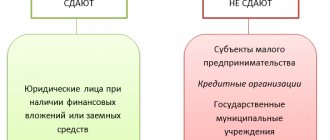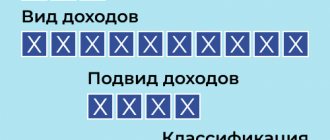Issues discussed in the material:
- What are the features of progressive, regressive and proportional tax systems
- What is the structure of the tax system in the Russian Federation
- What types of tax systems exist in the Russian Federation?
- How to choose the right tax system
The tax system includes taxes and fees paid by citizens and organizations to the federal, regional and local budgets and ensures that the state fulfills its functions. Today we will tell you what types of tax systems there are and what advantages each of them has.
Key Definitions
Speaking about the essence and types of tax systems, first of all we will present the key terms that will appear in this article.
Taxes are non-refundable, gratuitous, mandatory for the population and legal entities, regularly collected payments that are collected only by authorized government agencies in order to replenish the financial resources of a certain state.
The tax system is the total set of tax levies that are levied on taxpayers in accordance with the articles of the Tax Code of a particular state. This is a system necessarily regulated by legal norms, the main purpose of which is the establishment and collection of taxes.
The Tax Code (TC) is the main legislative act relating to taxation in the Russian Federation. It consists of two parts - the main one, which regulates the most general principles of constructing the tax system, and the special one, which establishes the basis for interaction between the state and the taxpayer on certain tax collections.
The basis of any type of tax system will be fees and taxes. With its help, a rule of law state can fully realize its functions both in managing financial traffic and its entire economy as a whole. In Russia, the tax system is regulated by the Tax Code and the Constitution. As in many other federal states, it is three-tiered - consisting of federal, regional and local taxes.
Tax levels
In addition to the fact that the listed principles must always be taken into account, there is also a need to monitor the fulfillment of such duties at as many as three levels.
The system of taxation and fees is divided into three sections, depending on the territorial and subordination structure of the state:
- for federal taxes/fees,
- to regional
- to local ones.
Each of the listed levels has its own characteristics. The level of collection and accrual is prescribed in the Tax Code and is also separately regulated by local regulations. Some deduction rates vary by location.
Federal level
All federal taxes are listed in the Internal Revenue Code. Whether you want it or not, they are mandatory for everyone, and no city in the country can hide from them. No, of course, everyone is not obliged to pay in full for all types, but if a citizen has something to do with taxable production or cash flow, then he will have to share a little. Unlike other taxes, these must go directly to the treasury. The federal tax system, or rather its level, includes the following types of fees:
- Value added (VAT). As a rule, it is paid for by businessmen, “private traders” who have businesses related to services that allow them to receive benefits.
- Excise taxes.
- For income. It applies to everyone, including individuals and any businessmen. It just so happens that if you receive something, you are obliged to give a percentage to the state fund, at least for the fact that you were given such an opportunity to receive it.
- To fossils. This primarily concerns those involved in their development and production.
- Unified social tax.
- Water and other types of fees provided for in Article 13 of the Tax Code.
Regional level
In addition to the fact that the Tax Code provides a list of federal taxes, it also contains regional ones, that is, those that do not apply to everyone, but only to residents of a specific part of the country. Such deductions should go to the appropriate budget cell. The taxation system in Russia invites the constituent entities of the federation to independently issue laws that would expand their powers to conduct tax affairs. Of course, there are limits, but this, as a rule, is not so consoling, because taxes are still mandatory for everyone who lives in a particular region. So what fees are included here? You can look at them in Article 14 of the Tax Code:
- on the property of organizations,
- for the gaming business,
- transport tax, which everyone who owns or plans to acquire a car will have to face.
The official powers that have been given to regional authorities, as a rule, relate not so much to the assignment of new taxes, which citizens cannot help but rejoice at, but rather to the order and method of payment provided for by law. At the level of federal legislation, the go-ahead is given for the distribution of tax rates within certain limits, but the system of the tax authorities of the Russian Federation of this particular subject sets the specific percentage or amount for its region at its own discretion.
Of course, everyone argues for the existence of huge volumes of work and financial need in the subject of the federation, therefore, as a rule, one cannot count on the minimum limit of this range.
Local level
And if someone felt the excitement of paying all the previous types of tax, then he will be pleased with the presence of local mandatory fees. These exist at the level of municipal departments and are prescribed by the Tax Code of the Russian Federation in conjunction with the regulations of local governments. It’s nice that by paying these taxes, there is hope that you will actually see the result - where exactly the taxpayers’ money went, because all local-level fees go directly to the municipal budget. True, the state has taken some trouble here too, leaving only land taxes and property taxes for individuals at the local level. However, the municipalities say thank you, and the payers are counting their money after having to fork out on all three levels.
Thus, the tax system of the Russian Federation at the local level, like the regional ones, are able to independently resolve only issues of the tax rate (if the state provides the opportunity), as well as decide when and how residents should pay all this.
It should be said that although there are a lot of taxes, as it seems, the taxation system in the Russian Federation does not yet include a number of other duties. For example, customs duties, or special payments for the use of forests, are also not included in the fee for environmental pollution. However, despite the fact that these payments are not considered taxes, no one prevents them from being collected under other (non-tax) laws.
Types of tax systems
There are two main types of tax systems:
- Global. Profits of both individuals and legal entities are subject to the same tax burden. The calculation of the tax fee is very simple, which benefits entrepreneurs - they can plan in advance the final amount of their income minus these payments. This system is most typical of Western countries.
- Shedular (schedula - part or share). A person’s entire income is divided into certain parts, each of which is subject to a specific tax. Each schedule has its own rates, criteria, benefits, etc.
There is also the following division of types of tax systems according to a number of important characteristics:
- Eurocontinental. It is characterized by a high share of contributions to social insurance and a predominance of indirect taxes over a very small number of direct taxes. Applicable in France, Belgium, Austria, Germany and the Netherlands.
- Anglo-Saxon. The share of direct taxes prevails over indirect ones, and taxation most affects individuals. Typical for the UK, Canada, USA, Australia.
- Latin American. Indirect taxation significantly prevails over direct taxation. An important feature is that tax collection is efficient even in conditions of inflation. Typical for Peru, Chile, Bolivia.
- Mixed. Combines the features of several types of tax systems. It is introduced to expand the tax structure, as well as to avoid dependence of the state budget on one type of taxes. Typical for the Russian Federation.
Tax system of the Russian Federation and problems of its improvement
The main activity of the tax system is the creation of a rational, effective and fair mechanism that would ensure decent economic growth for the entire state. However, as practice shows, the key direction is to increase the incentive to collect fiscal payments.
At the same time, increasing incentives for collecting fiscal obligations allowed the Russian economy to reach a new, higher level of development. This is due to the fact that legislators have proposed rational types and regimes of taxation that reduce the fiscal burden of payers. Consequently, the majority of economic entities decided to exit the shadow economy. However, current approaches are imperfect and require numerous changes.
Legal documents
- Article 1 of the Tax Code of the Russian Federation. Legislation of the Russian Federation on taxes and fees, legislation of the constituent entities of the Russian Federation on taxes and fees, regulatory legal acts of representative bodies of municipalities on taxes and fees
- Article 143 of the Tax Code of the Russian Federation. Taxpayers
Types of taxes
When talking about the tax system, it would also be useful to touch upon the essence and types of taxes. There are three main types of these payments in the Russian Federation:
- Federal: entering the state treasury.
- Regional: collected in favor of a specific region - republic, region, territory.
- Local: going to the budget of a specific entity - city, village, town, etc.
Taxes are classified according to the type of taxpayer:
- From individuals - to their income, property, etc.
- From legal entities - for profit, VAT, etc.
- Mixed.
According to the object of taxation, tax fees are allocated to:
- income;
- consumption;
- property;
- capital.
By type of seizure:
- straight;
- indirect.
We present some features of the latest classification in the following table.
| Indirect taxes | Direct taxes | |
| By payment method | Shifted to the shoulders of third parties, consumers | Contributed by the taxpayer himself |
| By method of collection | By tariffs | According to cadastres, salary documents |
| By economic basis | Charged from expenses, use, consumption | Levied from production, profit, property |
Now let us mention the main functions of tax payments.
Structure
Based on the provisions of the previous paragraph, it is easy to establish a three-level composition of the tax system of the Russian Federation. It corresponds to the hierarchy of legislative acts in the Russian Federation. The tax system of the Russian Federation consists of levels: federal, regional, local and includes all types of mandatory payments.
Below is the structure of the tax system of the Russian Federation: the scheme includes all mandatory payments currently established in the country.
The legislation on obligatory payments of the Russian Federation and its principles are constantly criticized by the opposition and business representatives for the lack of proper structuring and the possibility of double and even triple taxation. The state periodically reforms laws in this area, but the main hierarchy of payments to the budget remains unchanged, since it is determined by the state structure.
Legal documents
- tax code
Functions of taxes
Continuing the conversation about the tax system, types and functions of taxes, it remains to talk about the last point. There are several functions:
- The fiscal function is the most important. It is thanks to it that the state budget is formed.
- Social - redistribution of income in favor of socially disadvantaged groups.
- Regulatory - solving certain problems at the state level with the help of tax policy. It has stimulating, destimulating and reproductive subfunctions.
- Control - state monitoring of the timeliness and completeness of financial traffic to the treasury.
Quality criteria for tax systems
We analyzed the functions and types of the state tax system. Let's move on to its quality criteria:
- Balancing the state budget is ensuring the state treasury with the planned amount of funds that are necessary to carry out its functions as defined by law.
- A stable state of the economy - when implementing a certain tax policy, there should be an increase in production, development of economic sectors and regions of the country.
- Stable prices - the ratio of “direct-indirect taxes” should ensure price stability and prevent an increase in the level of inflation.
- The effectiveness of social policy - the tax system should not worsen the standard of living of citizens, especially socially vulnerable groups.
- Proper level of public awareness - taxpayers must clearly know when, where and in what volume they must send their payments to the state.
Principles of building the tax system in the Russian Federation
Talking about the concepts and types of tax systems, one cannot fail to note the principles of constructing such a structure specifically for the Russian Federation. They were formed in the Tax Code of our state:
- The obligation of every person to pay fairly determined taxes.
- Taxation in the Russian Federation is characterized by universality and equality.
- Taxes have no right to be discriminatory - based on nationality, religion, race or other criteria.
- Tax rates do not depend on the citizenship of a person, the form of his property, or sources of capital.
- Taxes cannot be arbitrary.
- Taxes should not create obstacles to free economic activity carried out within the framework of the law.
- No one is obliged to pay taxes in a different amount or order than that determined by the Tax Code of the state.
- Legislative acts on taxation must be written in a language that is understandable and accessible to citizens.
- All ambiguities and vague definitions of tax legislation are interpreted in favor of the taxpayer.
Fiscal system of the state: a brief history
Taxes and the tax system of the Russian Federation on the territory of our state began to emerge quite a long time ago. However, the structure most characteristic of modern realities was organized only in 1991. At that moment, a law was adopted, which was called: “On the fundamentals of the tax system in Russia.” This standard introduced many fiscal burdens, such as VAT, personal income tax (income tax at that time), excise taxes on tobacco and alcohol and other fees.
Already in 1998, the first part of the Tax Code of the Russian Federation was approved, and two years later, in 2000, legislators adopted the second part. Thus, the Tax Code became the main legal basis of the tax system of the Russian Federation. The regulation defined in detail the order of relations between the state and taxpayers.
The transformations affected not only the country's tax system itself, but also the bodies exercising control. So, in 1990 the State Tax was created. inspection, which was entrusted with the functions of control and collection of fiscal payments. Then it was renamed service. But already in 1998 the service was abolished, and in its place a special Ministry of Taxes and Duties was created.
However, this is not the last change. In 2004, officials decided to transfer budgetary powers to the Ministry of Finance of the Russian Federation. The control function was transferred to the Federal Tax Service, a service that still operates to this day. Consequently, a single centralized system of tax authorities consists of the Ministry of Finance of Russia and the Federal Tax Service.
Key trends in the development of tax systems
The optimal set of characteristics that every tax system ideally strives for is the following:
- Reducing the tax burden on commodity producers.
- Simplification of tax legislation.
- Replacement of taxes for enterprises with rent from the exploitation and processing of natural resources.
- Increasing the share of direct and reducing the volume of indirect taxes.
- The development of so-called tax federalism is the delimitation and distribution of taxes between the levels of the entire budget system of the state.
- Building a tax policy that depends only on objective conditions set by the economy.
- Increasing the level of tax culture of the population.
- Striving for perfect tax equality by smoothing tax breaks.
- Improving the system of control and punishment of tax offenses.
- Building a tax system that quickly adapts to changes in the economic situation in the country.
Construction principles
It is impossible to understand such a complex concept without defining the principles of its construction. Thus, all the principles of formation and construction of the tax structure of the Russian Federation are described in Article 3 of the Tax Code of the Russian Federation. These should include:
- justice, that is, the burden applies to everyone (citizens, individual entrepreneurs, organizations);
- certainty that does not allow ambiguous interpretations of the same provision, rule, norm;
- equality is established regardless of racial, social, religious, national and other principles;
- accessibility, that is, all norms must be formulated in the most accessible and understandable language;
- convenience, taxpayers must be informed about all mandatory payments, objects of taxation and procedures for calculating the amount of the obligation;
- validity, all existing and new obligations must be economically justified, it is unacceptable to introduce encumbrances that contradict the Constitution of Russia.
Consequently, the principles of taxation are aimed at complying with the current legislation and the fundamentals of the Constitution.
Types of taxation systems in the Russian Federation
Speaking about the types of tax system in Russia, we will also mention the types of taxation systems established for individual entrepreneurs, LLCs and other legal entities:
- Basic tax system (OSN).
- Unified Agricultural Tax (USAT).
- Unified tax on imputed income (UTII).
- Simplified system (STS).
- Patent system (for individual entrepreneurs).
The correct functioning of the tax system is the key to a constant flow of revenue to the state budget, social security of citizens, and a stable state of the economy. Each state chooses the type that suits it. However, all tax systems are characterized by similar functions, design principles and development trends.
Tax regimes
When recalculating such a large number of taxes, you can really get very scared or at least surprised - when do you have time to pay everything? But in fact, for the existing 15 taxes, there are 5 types of special regimes, each of which significantly simplifies life.
Of course, the state cannot afford to lose any funds by simply removing the obligation to pay taxes. But the regimes are able to combine some of them together, and some are completely reset, turning into a single amount established for all.
Today, entrepreneurs and individual entrepreneurs can take advantage of: general, simplified, unified, unified agricultural and patent types of taxation. In general, the tax system is quite systematized and open.
Become an author
Become an expert






